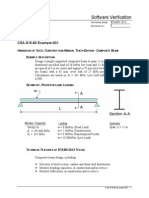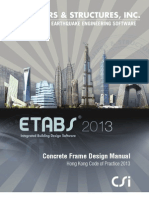Buckling 06
Buckling 06
Uploaded by
thanzawtun1981Copyright:
Available Formats
Buckling 06
Buckling 06
Uploaded by
thanzawtun1981Original Description:
Copyright
Available Formats
Share this document
Did you find this document useful?
Is this content inappropriate?
Copyright:
Available Formats
Buckling 06
Buckling 06
Uploaded by
thanzawtun1981Copyright:
Available Formats
Buckling-6
Buckling-6
Title
Lateral buckling of a simply supported cruciform column subjected to a concentric axial load
Description
A simply supported cruciform column consisted of narrow rectangular fins undergoes a vertical load P applied at the centroid of the top end. The buckling loads are determined for the three cases in which the column is divided into 10 and 20 beam elements and 80 plate elements. The computed buckling loads are then compared with the analytical exact solution. Case 1: 10 Beam elements evenly divided vertically Case 2: 20 Beam elements evenly divided vertically Case 3: 80 Plate elements evenly divided into 20 segments vertically
(a) Beam element model
(b) Plate element model
Structural geometry and boundary conditions
Verification Example
Model
Analysis Type Lateral torsional buckling Unit System kN, mm Dimension Length
3000mm
Element Beam element and plate element (thick type without drilling dof) Material Youngs modulus of elasticity Poissions ratio
E = 200kN/mm2 = 0.25
Section Property Beam element : combined section in a cruciform shape - thickness 6mm, width 300mm Plate element : thickness 6mm, width 150mm, height 150mm Boundary Condition Bottom end is pinned, and top end is roller. Load P = 1.0 kN
Buckling-6
Results
Buckling Analysis Results Case 1: Beam elements (total 10 elements) Buckling load
Case 2: Beam element (total 20 elements) Buckling load
Case 3: Plate element (total 80 elements) Buckling load
Verification Example
1st mode
2nd mode
3rd mode Isometric view of buckling modes of Case 3
4th mode
Buckling-6
1st mode
2nd mode
3rd mode
4th mode
Perspective Top view of buckling modes of Case 3
Verification Example
Comparison of Results
Case 1 2 3 Theoretical solution 458.086 Type of element Beam element Beam element Plate element No. of total elements 10 20 80 Critical load for 1st buckling 458.086 458.086 471.201 Unit: kN Error 0.00% 0.00% 2.86%
From the theory of elastic stability (Timoshenko and Gere [1]), the analytical solution for the tip cirtical load P cr is defined by the following expression:
Pcr =
GI xx A I A E = xx I y + I z I y + I z 2(1 + )
where, E = Youngs modulus of elasticity G = shear modulus of elasticity = poissons ratio
I y = moment of inertia about local y-axis
I z = moment of inertia about local z-axis
I xx = torsional moment of inertia
Substituting the material and sectional properties into the above equation gives the following result:
Pcr =
I xx A E 4.339636 104 3.564 103 200 = 7 I y + I z 2(1 + ) 2 1.350529 10 2(1 + 0.25)
= 458.086 kN
Reference
1. Timoshenko, S.P., and Gere, J.M., (1961). Theory of Elastic Stability, McGraw-Hill, New York.
You might also like
- Create An Employee Using PA30Document10 pagesCreate An Employee Using PA30RAMAKRISHNA100% (1)
- Finite Element Analysis LectureDocument37 pagesFinite Element Analysis LectureEhsan Elahi0% (2)
- CSA S16 09 Example 001Document7 pagesCSA S16 09 Example 001thanzawtun1981No ratings yet
- Bridge CollapsesDocument282 pagesBridge CollapsesED B. Lledo100% (8)
- 9720115-003 Emulator Users Guide v1.1.0 PDFDocument68 pages9720115-003 Emulator Users Guide v1.1.0 PDFBonbonchi BensNo ratings yet
- Buckling 03Document6 pagesBuckling 03thanzawtun1981No ratings yet
- Buckling 05Document8 pagesBuckling 05Dario Manrique GamarraNo ratings yet
- Lateral Torsional BucklingDocument24 pagesLateral Torsional BucklingAnonymous lEBdswQXmxNo ratings yet
- Buckling 01Document5 pagesBuckling 01thanzawtun1981No ratings yet
- UsmanaDocument20 pagesUsmanaUsman KuraghNo ratings yet
- Chapter 3. Plastic Analysis For Structure. BDocument36 pagesChapter 3. Plastic Analysis For Structure. BIyœ MøsisæNo ratings yet
- Mechanics of Materials ECVL 268: Extracting The Modulus of Rigidity of Materials Through Torsion TestDocument13 pagesMechanics of Materials ECVL 268: Extracting The Modulus of Rigidity of Materials Through Torsion TestAmy ParkerNo ratings yet
- Ib Tutorial 4 (12 13) Sem 2Document5 pagesIb Tutorial 4 (12 13) Sem 2omarnasriNo ratings yet
- Assignment 2-Plane Stress-Strain ProblemsDocument3 pagesAssignment 2-Plane Stress-Strain ProblemsInoshan Madushika JayawickramaNo ratings yet
- Theory of PlasticityDocument10 pagesTheory of Plasticitybabu1434100% (1)
- Structural Integrity Assessment On Solid Propellant Rocket MotorsDocument75 pagesStructural Integrity Assessment On Solid Propellant Rocket MotorsAzeem KhanNo ratings yet
- International Journal of Engineering Research and DevelopmentDocument5 pagesInternational Journal of Engineering Research and DevelopmentIJERDNo ratings yet
- 3.9. Self-Study ProblemsDocument9 pages3.9. Self-Study Problemsfahmiamri93No ratings yet
- Lecture3 - Concrete DesignDocument44 pagesLecture3 - Concrete Designbhairavthakkar1975No ratings yet
- Chapter 03 Mechanical PropertiesDocument8 pagesChapter 03 Mechanical PropertiesSumaya MahmoodNo ratings yet
- Rail Wheel 1Document28 pagesRail Wheel 1rajanjasuNo ratings yet
- Example 3 - S-Beam CrashDocument13 pagesExample 3 - S-Beam CrashSanthosh LingappaNo ratings yet
- FEM 7th Sem NIT Raipur QPaperDocument22 pagesFEM 7th Sem NIT Raipur QPaperShashi Bhushan PatelNo ratings yet
- RAD CourseworkDocument12 pagesRAD CourseworkAlfieNo ratings yet
- Structure No LinealDocument10 pagesStructure No LinealArte MachacaNo ratings yet
- Study of Plastic Hinge Formation in Steel BeamsDocument22 pagesStudy of Plastic Hinge Formation in Steel BeamsTejas PatilNo ratings yet
- Corrugated Web BeamDocument4 pagesCorrugated Web BeamNegin MalekiNo ratings yet
- Ductility of Connections Bolted Connections: N M M N M MDocument1 pageDuctility of Connections Bolted Connections: N M M N M MzewhiteNo ratings yet
- The Optimisation of Shot Peen Forming ProcessesDocument5 pagesThe Optimisation of Shot Peen Forming ProcessesbkhmohamedNo ratings yet
- Stress and loadDocument12 pagesStress and loadCarlo_FilippinNo ratings yet
- 1986 Kozo IkegamiDocument19 pages1986 Kozo IkegamiVenkatesan MNo ratings yet
- CIV 4235 ExamDocument9 pagesCIV 4235 Exammalumius100% (2)
- Buckling of StrutsDocument15 pagesBuckling of Strutsalextty100% (1)
- ME 6603 Question Bank: Unit I - Introduction Part-A (2-Marks)Document6 pagesME 6603 Question Bank: Unit I - Introduction Part-A (2-Marks)Bharathi KannaNo ratings yet
- Me 2353 - Finite Element AnalysisDocument4 pagesMe 2353 - Finite Element AnalysiscprabhakaranNo ratings yet
- Propped Cantilever Mesh Convergence Study Using Hexahedral ElementsDocument10 pagesPropped Cantilever Mesh Convergence Study Using Hexahedral ElementsSaad Al HelyNo ratings yet
- Tension TestDocument7 pagesTension TestmanmathkNo ratings yet
- FEA Question Bank Unit IDocument10 pagesFEA Question Bank Unit IPrathamesh PatikNo ratings yet
- Extended Abstract (R)Document3 pagesExtended Abstract (R)Eshwar G PawarNo ratings yet
- ME Web ModuleDocument95 pagesME Web ModuleAndrewFranciscoNo ratings yet
- Lecture On NanocompositesDocument44 pagesLecture On Nanocompositeskire14pffNo ratings yet
- Plastic AnalysisDocument23 pagesPlastic AnalysisPraveen Kumar R100% (1)
- QBank FEMDocument12 pagesQBank FEMShivam ChoudharyNo ratings yet
- FEA TutorialsDocument14 pagesFEA Tutorialsbalusharma1212No ratings yet
- A Simple Method To Determine Ductile Fracture Strain in A Tensile Test of Plane Specimen'SDocument5 pagesA Simple Method To Determine Ductile Fracture Strain in A Tensile Test of Plane Specimen'SksNo ratings yet
- Unit - Iv Plastic Analysis of StructuresDocument32 pagesUnit - Iv Plastic Analysis of StructuresOraib AljaafrehNo ratings yet
- Q&a FeaDocument19 pagesQ&a FeaKishoreNo ratings yet
- My PaperDocument9 pagesMy PaperBelal HyariNo ratings yet
- Kings: College of EngineeringDocument10 pagesKings: College of Engineeringmanivannan_mageshNo ratings yet
- Yu 2011Document6 pagesYu 2011George NabilNo ratings yet
- Solution - Shape FactorDocument6 pagesSolution - Shape FactorVenkata DineshNo ratings yet
- Course Manual 2202Document26 pagesCourse Manual 2202Emily SimpsonNo ratings yet
- Static-38 MidsDocument4 pagesStatic-38 MidsPojok SipilNo ratings yet
- 08 Notch SensitivityDocument8 pages08 Notch SensitivityamokhtaNo ratings yet
- Sheet Metal OperationsDocument52 pagesSheet Metal OperationsthakruNo ratings yet
- A Simple Numerical Method For Biaxial Bending Moment-Curvature Relations of Reinforced Concrete Column SectionsDocument9 pagesA Simple Numerical Method For Biaxial Bending Moment-Curvature Relations of Reinforced Concrete Column SectionsthduynguyenNo ratings yet
- Astm A227Document5 pagesAstm A227Diganta KonerNo ratings yet
- Design and Analysis of Composite Structures for Automotive Applications: Chassis and DrivetrainFrom EverandDesign and Analysis of Composite Structures for Automotive Applications: Chassis and DrivetrainNo ratings yet
- Dynamic Damage and FragmentationFrom EverandDynamic Damage and FragmentationDavid Edward LambertNo ratings yet
- Internal Combustion Engine Bearings Lubrication in Hydrodynamic BearingsFrom EverandInternal Combustion Engine Bearings Lubrication in Hydrodynamic BearingsNo ratings yet
- The Scaled Boundary Finite Element Method: Introduction to Theory and ImplementationFrom EverandThe Scaled Boundary Finite Element Method: Introduction to Theory and ImplementationNo ratings yet
- From Microstructure Investigations to Multiscale Modeling: Bridging the GapFrom EverandFrom Microstructure Investigations to Multiscale Modeling: Bridging the GapDelphine BrancherieNo ratings yet
- Supracadd T944 M2056 To PrintDocument18 pagesSupracadd T944 M2056 To Printthanzawtun1981No ratings yet
- WallDocument6 pagesWallthanzawtun1981No ratings yet
- Concrete Frame Design Manual: Hong Kong Code of Practice 2013Document57 pagesConcrete Frame Design Manual: Hong Kong Code of Practice 2013Nguyen Duc HoaNo ratings yet
- SFD Aisc 360 10 PDFDocument191 pagesSFD Aisc 360 10 PDFthanzawtun198183% (6)
- SFD NZS 3404 1997Document103 pagesSFD NZS 3404 1997thanzawtun1981No ratings yet
- StruCAD3D ImportDocument37 pagesStruCAD3D Importthanzawtun1981No ratings yet
- CBD BS 5950 90Document190 pagesCBD BS 5950 90thanzawtun1981No ratings yet
- CBD Csa S16 09Document195 pagesCBD Csa S16 09thanzawtun1981100% (1)
- Aci 530 11 Masonry Wall 002Document4 pagesAci 530 11 Masonry Wall 002thanzawtun1981No ratings yet
- NZS-3404-1997 Example 002Document5 pagesNZS-3404-1997 Example 002thanzawtun1981No ratings yet
- Aci 318-08 Wall-001Document4 pagesAci 318-08 Wall-001thanzawtun1981No ratings yet
- Aisc-Lrfd93 Example 002Document7 pagesAisc-Lrfd93 Example 002thanzawtun1981No ratings yet
- BS 5950-2000 Example 001Document5 pagesBS 5950-2000 Example 001thanzawtun1981No ratings yet
- AISC 360 05 Example 002Document6 pagesAISC 360 05 Example 002thanzawtun1981No ratings yet
- VTS User's Guide 4.6Document176 pagesVTS User's Guide 4.6vkky2k8120No ratings yet
- Case Study JetstarDocument5 pagesCase Study JetstarVosarogo Sera0% (1)
- The Shift To Digital Construction Ebook FinalDocument15 pagesThe Shift To Digital Construction Ebook FinalcristicomanNo ratings yet
- Introduction of Programming and Flow Chart 01Document5 pagesIntroduction of Programming and Flow Chart 01Vipin KumarNo ratings yet
- Week 15 - CRYPTOGRAPHY-1Document26 pagesWeek 15 - CRYPTOGRAPHY-113PLAN, SENTH RUEN, ANo ratings yet
- Pratap 11Document6 pagesPratap 11Siyyadula Chandra SekharNo ratings yet
- Bellman Ford AlgorithmDocument5 pagesBellman Ford Algorithmvisha.vikal28No ratings yet
- RastaDocument192 pagesRastaOlgaMawuntuNo ratings yet
- AcumaticaERP AccountsPayable PDFDocument334 pagesAcumaticaERP AccountsPayable PDFpaulinoemersonpNo ratings yet
- AS/A Level Mathematics Integration: Mathsgenie - Co.ukDocument3 pagesAS/A Level Mathematics Integration: Mathsgenie - Co.ukИРадојичићNo ratings yet
- Knowledge Area Quiz Project Procurement Management Practice Questions-Answer Key and ExplanationsDocument3 pagesKnowledge Area Quiz Project Procurement Management Practice Questions-Answer Key and ExplanationsDanish Habib100% (1)
- 0001 Ucpl Sap Fico s4 Hana SyllabusDocument12 pages0001 Ucpl Sap Fico s4 Hana SyllabusUCPL Training50% (2)
- Ospf Neighbor States Explained With ExampleDocument19 pagesOspf Neighbor States Explained With ExampleMark BrownNo ratings yet
- All PDF Merged Complete TocDocument755 pagesAll PDF Merged Complete TocSHIVAM GARGNo ratings yet
- Details of Transtion Goven by REDBUSDocument1 pageDetails of Transtion Goven by REDBUSruturaj v delekarNo ratings yet
- The Australian National University: Semester Examination - June 2009 MATH1014 - Mathematics and Its Applications IIDocument12 pagesThe Australian National University: Semester Examination - June 2009 MATH1014 - Mathematics and Its Applications IIJoshua HalimNo ratings yet
- It's Going VIRL Guide Cisco VIRL Lab Training - Technet24 PDFDocument196 pagesIt's Going VIRL Guide Cisco VIRL Lab Training - Technet24 PDFanu johnNo ratings yet
- SapDocument8 pagesSapGella Melissa Cortez HilarioNo ratings yet
- Operators and Expressions in C++Document32 pagesOperators and Expressions in C++Neena SharmaNo ratings yet
- GTT NOC Customer Support Guide PDFDocument19 pagesGTT NOC Customer Support Guide PDFSudhakar Ganjikunta100% (1)
- New Microsoft Word DocumentDocument2 pagesNew Microsoft Word Documentkumar_34_praveenNo ratings yet
- Excel 2010 Topics PDFDocument1 pageExcel 2010 Topics PDFRanjan KhandelwalNo ratings yet
- Cim 2nd AssignmentDocument4 pagesCim 2nd AssignmentkhalidhusanNo ratings yet
- PCIe Equalization v01Document7 pagesPCIe Equalization v01Saujal Vaishnav100% (1)
- Java Handout KKVDocument5 pagesJava Handout KKVKollipara KanakavardhiniNo ratings yet
- Graph Theory 2 - Subgraphs NotesDocument5 pagesGraph Theory 2 - Subgraphs NotesQuincy SproulNo ratings yet
- 1 PDFDocument1 page1 PDFHayman AhmedNo ratings yet
- How To Install ONOS On Ubuntu PDFDocument8 pagesHow To Install ONOS On Ubuntu PDFSeyhaSunNo ratings yet









































































































